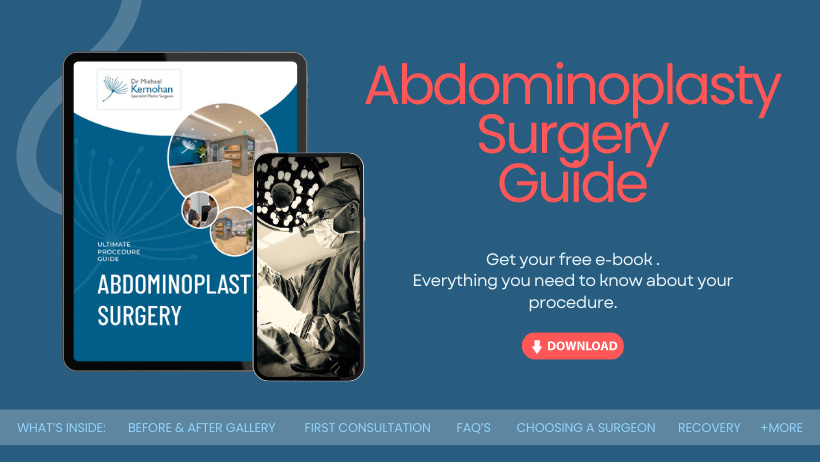Causes and Solutions to Manage Bruising after Fleur De Lis Surgery
Undergoing Fleur De Lis surgery is associated with significant changes in body contour. However, like all surgical procedures, it comes with its share of post-operative challenges, one of which is bruising after Fleur de Lis surgery.
In this blog, Sydney Specialist Plastic Surgeon Dr Michael Kernohan will explore effective strategies to minimise bruising and facilitate a smoother, more comfortable recovery process.
Take the Quiz
Why Bruises Occur after Fleur de Lis Surgery
Bruises after surgery, such as Fleur De Lis surgery, occur due to the body’s natural response to the trauma of the surgical procedure. Here’s a detailed explanation of how bruises form:
- Tissue Trauma: During surgery, there is inevitable trauma to the tissues, including skin, muscle, and sometimes even deeper structures. This trauma is caused by incisions, repositioning of tissues, and manipulation during the procedure
- Blood Vessel Damage: The surgical process can lead to the rupture or damage of small blood vessels, particularly capillaries, which are the smallest blood vessels in the body. When these vessels are damaged, blood leaks out into the surrounding tissues
- Blood Accumulation: The leaked blood accumulates in the tissue spaces outside of the blood vessels. This pooling of blood in the tissue causes the typical discolouration seen in a bruise. Initially, bruises may appear reddish due to the fresh blood, but as the blood starts to break down and is reabsorbed by the body, the bruise can change colours, often turning blue, purple, green, or yellow
- Inflammatory Response: The body’s natural inflammatory response to the surgical trauma also contributes to bruising. This response causes swelling and can increase the leakage of blood from the capillaries
- Body’s Healing Process: Over time, the body starts to heal. White blood cells and other mechanisms work to break down and reabsorb the blood that has leaked out. As this process progresses, the bruise gradually fades and the affected area returns to normal
Factors Influencing Bruising
The extent and severity of bruising can vary depending on many factors, including the patient’s age, skin type, overall health, the specific nature of the surgery, the plastic surgeon’s technique, and how the patient’s body reacts to trauma. Here are more details about these factors:
- Patient’s Age: Age plays a significant role in how the body responds to trauma and heals. Older patients may experience more pronounced bruising, as skin and blood vessels become more fragile with age. The skin loses some of its protective fatty layer and elasticity, making it more susceptible to bruising
- Skin Type and Condition: The condition and type of a patient’s skin can also affect bruising. Thinner skin tends to bruise more easily compared to thicker skin. Additionally, certain skin conditions or dermatological issues might predispose individuals to more extensive bruising
- Overall Health and Medical Conditions: A patient’s general health significantly impacts how their body responds to surgery. Individuals with certain medical conditions, such as blood clotting disorders, diabetes, or liver disease, may bruise more easily. Medications like blood thinners or anti-inflammatory drugs can also increase the likelihood and severity of bruising
- Nature of the Surgery: The extent and location of the surgery play a crucial role in determining the amount of bruising. More extensive surgeries, or those involving areas with a dense network of blood vessels, can result in more bruising. Fleur De Lis surgery, for instance, involves significant tissue manipulation, which can lead to more pronounced bruising
- Surgeon’s Technique: The skill and technique of the surgeon are critical factors. A surgeon who employs meticulous techniques to minimise tissue trauma can reduce the extent of bruising. The use of advanced surgical instruments and careful handling of tissues during the procedure can also play a significant role
- Body’s Reaction to Trauma: Individual variations in the body’s response to surgical trauma can influence bruising. Some people naturally have a higher tendency to bruise due to factors like skin tone, blood vessel fragility, and genetic predispositions
- Nutritional Status: Nutrition is another important factor. Deficiencies in certain vitamins and minerals, such as Vitamin C, Vitamin K, and iron, can impair the body’s ability to heal and increase susceptibility to bruising
- Lifestyle Factors: Lifestyle choices, such as smoking and alcohol consumption, can exacerbate bruising. Smoking, in particular, impairs blood flow and can hinder the healing process, leading to more significant bruising and slower recovery
- Post-operative Care: How a patient manages their recovery can also impact bruising. Adhering to post-operative instructions, such as avoiding strenuous activities, applying cold compresses, and proper wound care, can significantly reduce the severity of bruising
Download Dr Kernohan’s Guide to Abdominoplasty – Tummy Tuck Surgery

What Can Lead to Accentuated Bruising after Fleur De Lis Surgery
Fleur De Lis surgery can sometimes result in pronounced bruising. Understanding the factors that can lead to accentuated bruising is important for patients undergoing this procedure. Here are some elements that can contribute to increased bruising:
- Blood Thinners and Certain Medications: Medications that thin the blood, including over-the-counter options like aspirin and ibuprofen, can increase the risk of bruising. Prescription blood thinners, certain herbal supplements (like fish oil, ginkgo biloba, and garlic), and even some vitamins (like vitamin E) can exacerbate bleeding and bruising. It’s important to discuss all medications and supplements with Dr Kernohan before the surgery
- Alcohol and Smoking: Alcohol consumption can increase bleeding risks, leading to more significant bruising. Smoking, on the other hand, impairs circulation and oxygenation of tissues, which can not only increase bruising but also slow down the healing process
- Nutritional Deficiencies: A lack of certain nutrients, particularly vitamins C and K, can worsen bruising. Vitamin C is crucial for collagen formation and wound healing, while Vitamin K plays a key role in blood clotting. A diet deficient in these nutrients can make a patient more prone to extensive bruising
- Pre-Existing Medical Conditions: Conditions that affect blood clotting or circulation, such as haemophilia, liver disease, or vascular disorders, can lead to increased bruising. It’s essential to disclose any such conditions to your plastic surgeon during the pre-operative consultation
- Age and Skin Elasticity: Older patients or those with less elastic skin may experience more pronounced bruising. As the skin ages, it becomes thinner and more fragile, making it more susceptible to bruising
- Patient’s Individual Healing Response: Individual differences in healing can also play a significant role. Some people naturally bruise more easily than others, and this can be influenced by genetic factors, overall health, and even lifestyle choices
- Inadequate Post-Operative Care: Failure to follow post-operative instructions, such as not using compression garments, inadequate rest, or engaging in strenuous activities too soon after the surgery, can exacerbate bruising and swelling
- Physical Activity Post-Surgery: Engaging in physical activities or exercises that strain the surgical area can lead to increased bruising and swelling. It’s crucial to allow the body adequate time to heal before resuming such activities
- Dehydration: Not maintaining adequate hydration levels before and after surgery can affect blood circulation and increase the risk of bruising
By being aware of these factors, patients can take proactive steps to minimise their risk of excessive bruising following Fleur De Lis surgery. It’s always important to have an open and thorough discussion with Dr Kernohan about your medical history, lifestyle, and any concerns you may have regarding bruising and recovery.
Dr Kernohan’s Top Tips to Reduce Bruising after Fleur de Lis Surgery
These tips are designed to help patients navigate their recovery more comfortably and effectively:
- Pre-Surgery Nutrition: Begin preparing your body weeks before the surgery. Focus on a balanced diet rich in vitamins and minerals. Vitamin C, known for its role in healing and collagen production, and Vitamin K, which aids in blood clotting, are particularly beneficial. Foods like citrus fruits, leafy greens, and lean proteins are excellent choices
- Avoid Certain Substances: At least two weeks prior to your surgery, avoid medications and supplements that can increase bleeding risk, such as aspirin, ibuprofen, and certain herbal supplements like ginkgo biloba, garlic, and fish oil. Also, refrain from alcohol and smoking, as they can impair healing and increase bruising
- Stay Hydrated: Good hydration is crucial both before and after surgery. It helps maintain healthy circulation and aids in reducing swelling and bruising
- Use of Arnica and Bromelain: Consider starting Arnica Montana and Bromelain supplements before the surgery. These natural remedies are known for their effectiveness in reducing swelling and bruising
- Post-Surgery Cold Compresses: Apply cold compresses to the affected area for the first 48 hours after surgery, but not directly against the skin. This can help reduce swelling and bruising
- Elevate the Surgical Area: Keep the operated area elevated as much as possible during the initial recovery phase. This helps in reducing blood pooling and minimises bruising
- Gentle Movement: While rest is important, gentle movements and light walking are encouraged to improve blood circulation, which aids in reducing bruising and swelling
- Adequate Rest and Sleep: Ensure you get plenty of rest and sleep with your body positioned correctly. Proper rest is crucial for your body’s healing process
- Follow Post-Operative Instructions: Adhere strictly to all post-operative care instructions provided by Dr Kernohan. This includes wound care, use of compression garments if recommended, and attending all follow-up appointments
- Monitor Your Progress: Keep an eye on your recovery. If you notice any unusual symptoms or if the bruising seems excessive, don’t hesitate to contact Dr Kernohan or your healthcare provider
FAQs about Fleur de Lis Surgery

How long do you stay in recovery after a tummy tuck – abdominoplasty?
- The recovery period after a tummy tuck – abdominoplasty can vary depending on individual factors such as the extent of the surgery, the patient’s overall health, and how their body heals. Most patients can expect to stay in the hospital for 1 to 3 days post-surgery for monitoring. The initial recovery phase, where significant rest is required, usually lasts for about 2 to 3 weeks. During this time, patients are advised to avoid strenuous activities and focus on healing. Complete recovery, where patients can return to all normal activities, including exercise, usually takes about 6 to 8 weeks.
How do I prepare for Fleur de Lis surgery to reduce bruising?
- To prepare for Fleur de Lis surgery and reduce bruising, start by following a healthy diet rich in vitamins and minerals, especially Vitamin C and K, to strengthen your body’s healing ability. Avoid medications and supplements that can increase bleeding, such as aspirin, ibuprofen, and certain herbal supplements like fish oil and vitamin E, for at least two weeks before the surgery. Stay hydrated and consider taking Arnica Montana and Bromelain supplements, as they are known to reduce swelling and bruising. It’s also crucial to stop smoking and limit alcohol consumption well in advance of the surgery, as these can impair healing. Lastly, ensure you have a support system in place for post-operative care and follow all pre-operative instructions provided by your surgeon.
What are the worst days of tummy tuck – abdominoplasty recovery?
- The most challenging days of tummy tuck – abdominoplasty recovery are usually the first few days following the surgery. During this period, patients often experience discomfort, swelling, and bruising, with pain being most pronounced. It’s common to feel tired and sore, and mobility may be limited. Pain management is crucial during this time, and it’s important to follow your surgeon’s instructions regarding medication and rest. The discomfort usually starts to decrease significantly after the first week, and patients begin to feel more comfortable and mobile.
How painful is a Fleur de Lis?
- The level of pain experienced during a Fleur de Lis surgery recovery can vary from person to person. Most patients can expect a moderate level of discomfort, particularly in the first few days post-surgery. Pain management is a critical aspect of recovery, and Dr Kernohan will prescribe pain medication to help control any discomfort. It’s important to follow these prescriptions and communicate with your surgeon about your pain levels. Most patients find that the pain becomes more manageable after the first week and significantly improves as the healing process progresses.
What are the complications of the Fleur de Lis tummy tuck – abdominoplasty?
- Like any major surgical procedure, the Fleur de Lis tummy tuck – abdominoplasty comes with potential risks and complications. These can include infection, bleeding, and reactions to anaesthesia. Specific to the Fleur de Lis procedure, there is a risk of significant scarring, as the surgery involves extensive incisions. Other potential complications include seroma (fluid accumulation), haematoma (blood accumulation), and issues with wound healing. There’s also a risk of changes in skin sensation or numbness around the operated area.
Further Reading about Body Surgery with Dr Michael Kernohan
- Read Dr Kernohan’s Abdominoplasty Surgery Page
- Read Dr Kernohan’s Post Weight Loss Contouring Page
- Read Dr Kernohan’s Belt Lipectomy Surgery Page
- Read Dr Kernohan’s Upper Body Lift NSW Surgery Page
- Read Dr Kernohan’s Blog about Recovery after Tummy Tuck or Abdominoplasty
- Read Dr Kernohan’s Blog about Will Medicare Cover My Fleur De Lis Surgery?
- Read Dr Kernohan’s Blog about Tips for Recovery after Fleur De Lis Surgery
Medical References about Fleur de Lis Surgery
- Tummy Tuck: What to Expect at Home – MyHealth Alberta
- Fleur-de-Lis abdominoplasty: a safe alternative to traditional abdominoplasty for the massive weight loss patient
- The Fleur-De-Lis abdominoplasty
- Abdominal contour surgery for the massive weight loss patient: the fleur-de-lis approach
- Tummy Tuck Surgery (Abdominoplasty) – WebMD








